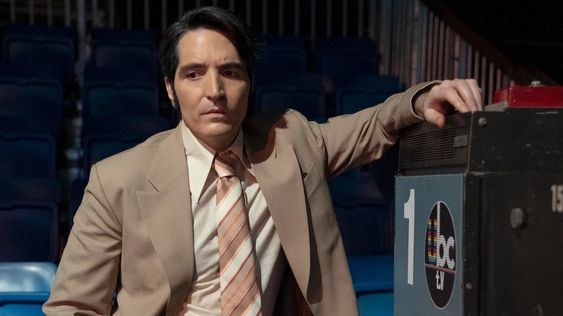Late Night with the Devil
Contains spoilers!

Recently, I watched a screening of “Late Night with the Devil.” It was not without its hiccups, however. The movie took an hour to start, leaving me to wonder if the delay stemmed from technical glitches or if someone backstage believed the film was corrupted. Given its found-footage style mixed with themes of corruption, it was not an entirely far-fetched assumption.
However, as the movie finally began, another obstacle emerged: faulty speakers. Every time the sound escalated, a crunchy distortion filled the theaters. When I revisited scenes online, I realized it was the theater’s equipment, not intentional audio manipulation. Ironically, this glitch only heightened the tension, especially during the climax, where the distorted sound added a layer of terror to the film.
Let us delve into the film’s finer details, starting with the smaller aspects like costuming, sets, and effects. We will save the plot for later.
The costuming in the film resonated with me, particularly the subtle yet impactful use of color-coding for character differentiation. Characters like Carmichael, who exuded arrogance and pretentiousness, were adorned in richer hues like fiery reds. At the same time, softer, more nuanced personalities like Lily were dressed in patterns of soft flowery motifs and soothing baby blues. Jack’s choice of a neutral-toned suit in tan subtly emphasized his character’s neutrality, a topic we will delve into later.
The set was a marvel to behold. The rainbow adorning the backdrop injected a delightful touch, balancing coziness with an undercurrent of impending dread. The deliberate arrangement of chairs, snugly placed during interview scenes, juxtaposed with the desolate emptiness beyond, hinted at a deeper narrative. While one might attribute this to the practicalities of a soundstage, I cannot help but feel it was a deliberate ploy to underscore Jack’s profound loneliness, portraying him as perhaps the loneliest soul in the universe.
Let us talk about the effects — oh boy, were they cheesy! The gore, in particular, was not my cup of tea, but it did fuel one of my suspicions: that everything we witnessed might have been a product of Jack’s mind. Perhaps the excessive gore served as hallucinations during his interviews with Lily and June or even during his supposed killing spree. But who is to say for sure? That worm hypnosis scene, though, was an absolute nightmare. Utterly revolting.
Now, let us dive into the plot that left me satisfied and scratching my head, much like many viewers. Several elements lingered in my mind, leaving me pondering their significance long after the credits rolled.
Take, for instance, the grieving mother’s revelation about her son’s recent passing. It left me puzzled. How did Christou come by this information? Was he genuinely gifted with psychic abilities, as the movie suggested? The elaborate nature of his demise certainly seemed to defy any explanation grounded in mere coincidence or pre-existing conditions. And what about that unsettling scene with the black goo shooting out of his mouth? It left me reeling, struggling to determine if that was what happened.
Then, there is the skeleton figure, a recurring person throughout the film. Despite the intense focus on it, its purpose remained frustratingly elusive. Was it merely a symbol, hinting at the omnipresent gaze of the cult members observing Jack’s every move? Or did it hold a deeper meaning waiting to be uncovered?
And let us not forget Abraxas. Is he still out there, lurking in the shadows? His ambiguous fate only adds to the confusion surrounding the film’s conclusion. Was it all a figment of Jack’s imagination, a descent into madness? Or was there a grain of truth buried beneath the layers of uncertainty?
I can’t entirely agree with the idea that Jack is inherently evil. He’s grappling with immense grief over his wife’s death, and that desperation might lead him down some dark paths. But deep down, I think he’s just longing to reunite with her, even if it means sacrificing everything else he holds dear, like his dwindling fame from the show. It’s heartbreaking. Jack isn’t driven by greed or malice; he’s just a shell of his former self, desperately searching for solace in the spotlight. In the Halloween 1977 Special, he’s essentially ridiculed for existing. So, no, Jack isn’t evil. He’s just lost, dug into a bottomless pit of despair.
There are subtle nods to “The Exorcist” in “Late Night with the Devil.” It’s not a carbon copy, but there are similarities if you look closely. Surprisingly, not many reviewers have picked up on this. Just one that I’ve come across even mentioned it.
Jack casually mentions exorcisms from the start, setting the stage for what’s to come. And as the plot unfolds, the parallels become more apparent. Take Jack himself, for example. He shares similarities with Damien. Both struggle in their respective professions, feeling lost despite years of dedication.
Then there’s the possession of the little girl, a classic horror trope. But what struck me is how both demons, in “Late Night with the Devil” and “The Exorcist,” target the emotionally vulnerable. Jack, in this case, just like Damien’s, struggles with his identity. The demons’ taunts hit close to home, too. In Damien’s case, it’s mocking his sexuality and his deep connection to his mother, echoing Jack’s yearning to fill the void left by Minnie. The attempted exorcisms unfold in a strikingly similar manner in both stories.
In conclusion, “Late Night with the Devil” is a captivating and thought-provoking addition to the horror genre. It deserves recognition for its storytelling and nods to cinematic classics like “The Exorcist.” While not without its flaws, particularly in its reliance on certain horror tropes, the film manages to carve out its own identity with a compelling narrative and well-executed performances.
Rating: ★★★★☆ (4/5)